Why use a thumbnail? A value study? A color study?
Here is a photo of a picture taken from Unsplash (see previous post for credits):
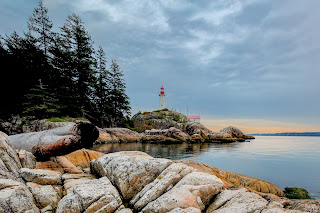
Here it is changed to a black and white.

Here are some questions to consider before I paint this:
1. What do I love most about this picture? Is it about the lighthouse? Or something else?
2. What do I find distracting or uncomfortable? (like that big dark spot on the log on the left?)
3. What details are important to keep? (if I want it to be a specific recognizable place, especially)
4. Is there anything that makes it feel off-balance?
5. Do I want to keep the mood created by cloudy skies, or change it?
6. What shapes can I combine and connect to give the painting continuity?
Here are three thumbnails done of the photo to explore possible compositions.
A thumbnail is generally a very small (like 4 x 6 or smaller), usually pencil, sketch. It lets you quickly compose different possibilities for framing your subject. It doesn't take more than 5 minutes to do, and can be done several times to compare possibilities.
This first sketch, about 2 1/2 inches by 4 inches, shows the composition as it is in the photo. I've drawn a line through the centers to show that the lighthouse, which I want to be a center of interest, is smack dab in the center. I also included the log on the foreground on the left, which I don't want in my final picture.
It also shows me that maybe I don't want all that heavy dark in the trees.
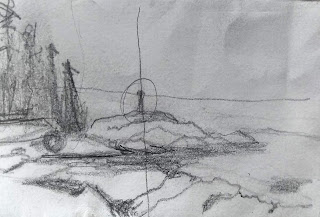
For this second thumbnail, I moved the lighthouse to the left and up a little bit to make it more important.(aiming for a good center of interest) This also raised the horizon line to above center. I lowered the trees a bit also and put more space in them.
I removed the foreground log I didn't care for. I like this composition better. I just need to make certain that I don't make my middle ground, foreground, and background equal in size.
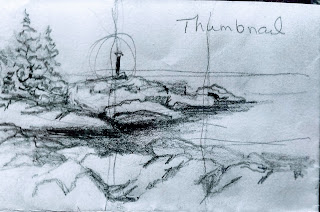
Just for funzies, I tried a thumbnail on a vertical. Again I divided it into thirds. When I do this, I can drop in my center of interest and draw around it. If I did paint this, I would not put in the trees as they appear in the photo. It throws off the balance of the picture.
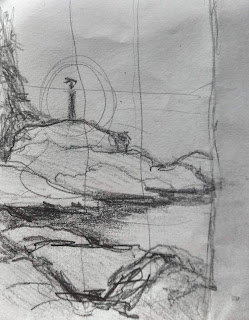
Now for the value study.
This is only 5 x 7, a very loose sketch with the most important shapes in. Using just one color that can go from very dark to very light (paynes gray/burnt umber/sepia/dark blue/ etc) I loosely painted in my values. It lets me know immediately where I might need to make changes in the darks and lights.
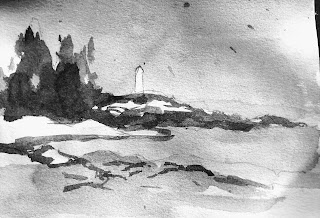
So, can you use your black and white copy as a value study? Ummmm, sure. But keep a white and black marker handy. There may be details you want to eliminate; values you want to make darker or lighter; an important detail to add in or move to another place. A shape to adjust.
Color study. (also a 5 x 7)
I wanted to play with color that would create the same mood as I get when I see this photograph. Maybe I want to recreate the colors exactly. But maybe I want to be more playful and see what I can get with other color combinations. I try to pick just three color that I think will work well together, not get too complicated. It may take more than one color study to decide what you like. If nothing else, you'll discover what NOT to use.
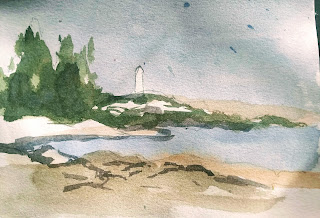
None of these steps should take very long. Mostly because you are only dealing with your basic shapes.
The point of these steps is to eliminate as many painting mistakes as possible before you commit to the final painting.
1. Thumbnails: to quickly discover a composition that you like
2. Value study: to quickly see where your lights and darks should go.
3. Color study: to quickly decide on basic colors for your composition.
These are like the ABC's of starting a painting. In reading, you don't always consciously think about each letter as you become more proficient at reading. And you may not consciously do each step as you paint. But you can save yourself a lot of grief if you at least consider each step before committing paint to paper.














